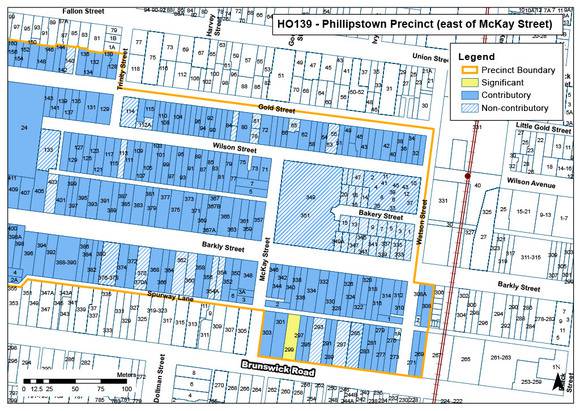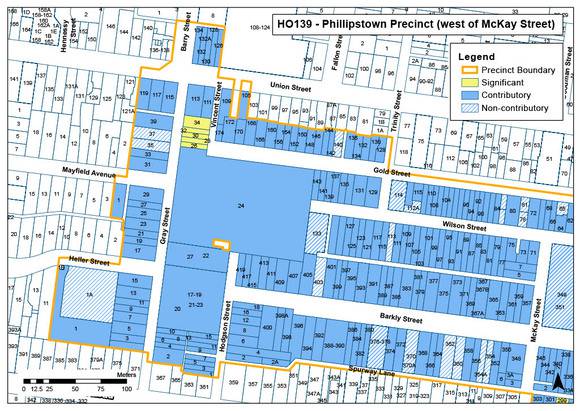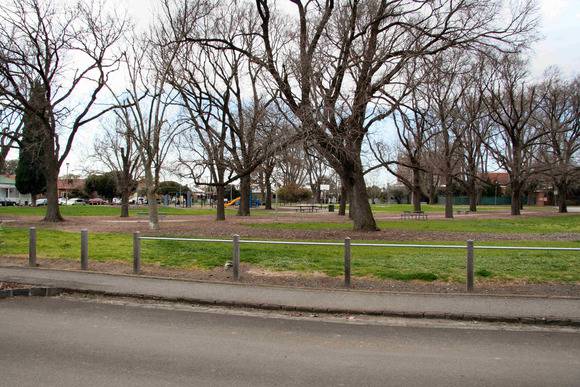| Back to search results » | Back to search page » |
|
Phillipstown
Location357-419 & 310-400 BARKLY ST, and 129-143 & 128-172 GOLD ST, and 1-39 & 2-34 GRAY ST, and 1 HELLER ST, and 1-29 & 2-18 HODGSON ST, and 1 MAYFIELD AVE, and 5-7 MCKAY ST and 109-119 & 126-136 UNION ST, and 9 WATSON ST and 33-133 & 30-114 WILSON ST, and 1-15 & 2-20 BAKERY ST, and 269-303 BRUNSWICK ROAD BRUNSWICK, MORELAND CITY
File Number3533LevelIncluded in Heritage Overlay |
|
Statement of Significance
What is significant?
The Phillipstown Precinct, comprising 357-419 and 308-400 Barkly
Street, 269-303 Brunswick Road, Spurway Lane, 1-15 and 2-20 Bakery
Street, 39-143 and 128-172 Gold Street, 1-39 and 2-34 Gray Street, 1A
and 1B Heller Street, 1-29 and 2-18 Hodgson Street, 1 Mayfield Street,
5-7 McKay Street, 105, 109-119 and 126-136 Union Street, Vincent
Street and 33-133 and 30-114 Wilson Street, is significant. Buildings
and features that contribute to the significance of the precinct are:
The following places of local significance have individual citations:
Non-Contributory properties include:
How is it significant?
Why is it significant? The Phillipstown Precinct is significant as an area of predominantly
Victorian and Edwardian housing. (Criterion E) It is especially
notable for the small, single fronted timber and brick dwellings that
date from as early as 1859 and are among the oldest in the Brunswick
area. These include the early terrace rows at 4-10 Gray Street and
1-15 Hodgson Street. (Criterion D) Other significant buildings
include:
- Houses and front fences dating from the Victorian to interwar
periods (c.1870 to c.1940)
- The former shops and residences at
126-134 Union Street and the Union Hotel at 109 Union Street
-
Factories dating from the late Victorian to interwar periods (c.1890
to c.1940)
- Temple Park and Gillbrook Park
- Bluestone kerb
and channel, bluestone laneways and crossovers.
- R.J. Henderson Factory (former), 393 Barkly Street (Hermes No.
57306)
- Stephens & Co. Clothing Factory (former), 20 & 22
Gray Street & 17-25 Hodgson Street (Hermes No. 57901)
- Temple
Park, 24 Gray Street (Hermes No. 59157)
- 299 Brunswick Road,
Brunswick (Hermes No. 201976)
- Bakery Street: 1-15 &
2-20
- Barkly Street: 333-355, 354, 354A, 360, 362, 370, 376 &
403
- Brunswick Road: 285 & 293
- Gold Street: 53, 55, 65,
75, 81 & 140.
- Gray Street: 35 & 37.
- Heller Street:
1A & 1B.
- Watson Street: 9.
- Wilson Street: 33-51, 78,
82, 113, 133, 112A and 114.
The Phillipstown Precinct is of local historical, aestheticand
architectural significance to the City of Moreland.
The Phillipstown Precinct is significant as the oldest settled
part of Brunswick with retention of elements of an early street
pattern established from the late 1840s and for evidence of the small
scale brick industry established in the area in the same period. These
industrial activities are evidenced both in the form of filled
clay-holes and in the form of small timber and brick dwellings on
small allotments built from the 1850s onwards, which were occupied by
brickwork workers and proprietors and associated tradespeople. It also
contains several factories, which demonstrate the growth of
manufacturing in Brunswick from the late nineteenth to mid-twentieth
centuries (Criterion A)
- The attached pair 'Tintern House' and 'Clifton House'
at 310 & 312 Barkly Street, which are very intact and notable for
their highly decorated boom-style parapets.
- The attached pair at
308 & 308A Barkly Street, which are designed to appear as a single
house and have unusual details such as the verandah/porch with its
circular openings and Classical style pilasters. The houses also
retain a Victorian style cast iron front fence, which is likely
associated with the earlier house on this site.
- The unusual
terraces at 26-34 Gray Street, which displays an unusual combination
of Italianate, Edwardian Queen Anne and Gothic styles.
- The
two-storey terraces with shops at ground level on the corner of Union
and Barry Streets.
- The house at 299 Brunswick Road, Brunswick.
Group
Residential buildings (private)
Category
Residential Precinct








